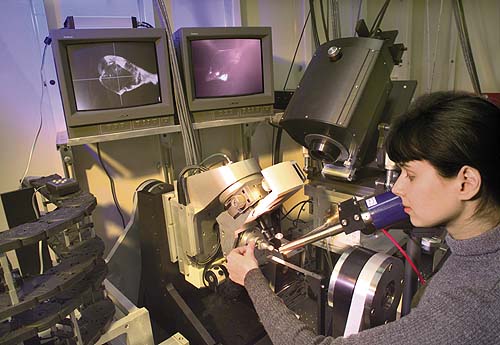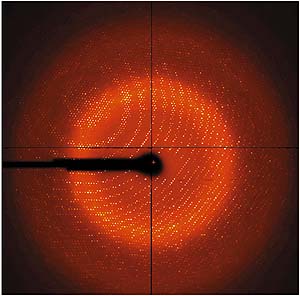 he standard scientific technique for studying the structure of biological molecules is x-ray crystallography. In this procedure, a beam of x-rays, sent through a crystal of protein, forms a diffraction pattern when the beam's photons are scattered by the crystal's atoms. This diffraction pattern can be translated into an image that reveals important details about the protein's atomic structure.
he standard scientific technique for studying the structure of biological molecules is x-ray crystallography. In this procedure, a beam of x-rays, sent through a crystal of protein, forms a diffraction pattern when the beam's photons are scattered by the crystal's atoms. This diffraction pattern can be translated into an image that reveals important details about the protein's atomic structure.
X-ray crystallography has seen limited use in membrane protein research, in part because of the difficulty of growing crystals that can strongly diffract x-ray photons. Obtaining useful images has required either a lot of expensive and difficult-to-make sample material, or more photons than conventional x-ray sources can deliver.

|
(Click on image to enlarge)
|
|
Researchers using the Macromolecular Crystallography Facility (MCF) at the Advanced Light Source use a number of different techniques to get detailed views of protein structures. For instance, a 38-pole wiggler magnet provides x-rays that are excellent for collecting multiple-wavelength anomalous diffraction (MAD) data with which to create images. Shown here is Natasha Khlebtsova, a member of the research group of MCF head Thomas Earnest.
|
Plenty of x-ray photons at wavelengths and energies that are ideal for peering inside living cells can be delivered by Berkeley Lab's Advanced Light Source (ALS). One of the nation's premier sources of x-rays and ultraviolet light, the ALS is an electron accelerator with a storage ring some 200 meters or about 660 feet in circumference. This storage ring is equipped with special magnetic devices, called "wigglers" and "undulators" that enable it to extract beams of photons from a highly energized beam of electrons.
One of these wigglers serves as the heart of the MCF. This wiggler provides highly collimated x-rays at wavelengths of 0.9 to 4.0 angstroms, the range that is used in the best crystallography techniques for imaging membrane proteins and other biological molecules.
"The exceptionally high flux and brightness of ALS light means we get high resolution images without the need for so much sample material," says Thomas Earnest, the Berkeley Lab biophysicist in charge of the facility. "ALS beams also allow us to collect data from crystals which diffract weakly or have large unit cell dimensions, both of which are typically true for membrane proteins."
The high flux of the ALS crystallography beamline places a heavy demand for high-speed detector readouts. Otherwise, valuable data could go unrecorded. For the time being, the MCF is making use of CCD (charge-coupled device) cameras that have a readout time of just under two seconds. CCD cameras are well-suited for the study of macromolecular crystals because they acquire diffraction pattern images on a photographic plate over a given exposure time. For future studies of dynamic processes, a new "pixel" detector is now being developed that will provide images of the changes a protein molecule undergoes during a biochemical reaction.
| Lead scientist on this project
|
|
|
|
|
|
The MCF, which began operations this past fall as a "national user facility" (meaning it is open to qualified users throughout the United States), is already making valuable scientific contributions. Researchers have used the facility's x-rays to determine the structures of a cholesterol-regulating protein, an important enzyme/inhibitor complex, and several DNA-binding proteins. Others are applying the MCF to structure-based pharmaceutical drug design, and to the study of ribosomes, the RNA-bearing molecular complexes responsible for protein synthesis in living cells.
"The state-of-the-art technology at the MCF provides scientists with a much needed tool to attack some of the most difficult problems presented in structural biology," says Earnest.
- Lynn Yarris



 he standard scientific technique for studying the structure of biological molecules is x-ray crystallography. In this procedure, a beam of x-rays, sent through a crystal of protein, forms a diffraction pattern when the beam's photons are scattered by the crystal's atoms. This diffraction pattern can be translated into an image that reveals important details about the protein's atomic structure.
he standard scientific technique for studying the structure of biological molecules is x-ray crystallography. In this procedure, a beam of x-rays, sent through a crystal of protein, forms a diffraction pattern when the beam's photons are scattered by the crystal's atoms. This diffraction pattern can be translated into an image that reveals important details about the protein's atomic structure.

